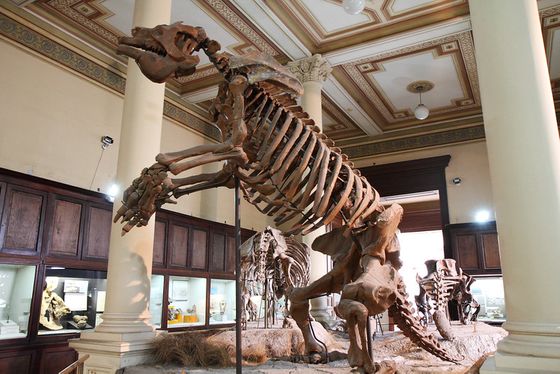Why did only South American mammals fail to thrive in North America after the North and South Americas were connected?

by
About 3 million years ago, the formation of the Isthmus of Panama, which connects the Americas, created a major crossroads between the Americas , where North American animals moved to South America and South American animals to North America. At this time, there was a situation that 'North American mammals prospered in South America, while South American mammals did not prosper in North America', and an international research team published a paper approaching the mystery. doing.
Disproportionate extinction of South American mammals drove the asymmetry of the Great American Biotic Interchange | PNAS
https://www.pnas.org/content/early/2020/09/29/2009397117
What Happened to South America's Missing Mega-Mammals? --The New York Times
https://www.nytimes.com/2020/10/08/science/mammals-south-america-extinction.html
The mass extinction at the end of the Cretaceous has extinct 70% of all species, and the previously prosperous dinosaurs have disappeared from Earth. Mammals emerged after that, and it was said that there was a lot of mammals coming and going between North America and Asia, which were once land-based.
On the other hand, South America, which had been independent of North America for many years, had its own strange ecosystem. Is a closely related species of giant sloth megaterium , such as rhino is no horns toxodon , the huge mammals close to the armadillo glyptodon , with a huge tusks marsupial of thylacosmilus habitat such as, unique mammals in South America was doing.
The major change in this situation is the connection between North and South America due to crustal movements. Before the formation of the Isthmus of Panama, it seems that mammals have been coming and going on both continents since about 4 million years ago, and the formation of the Isthmus of Panama has activated the movement of animals. This phenomenon is called the Great American Interchange.

For many years, paleontologists have faced a mystery surrounding the Great American Interchange. That is, 'In South America, mammals with roots in North America have increased dramatically, while in North America, mammals with roots in South America have not increased much.' Certainly some mammals have moved from South America to North America, but only a few species, such as
Regarding the reasons for the asymmetry in the movement of mammals at the Great Intercontinental Crossing, 'The theory that the number of mammals that moved from North America to South America was greater than the number that moved from South America to North America' 'Intercontinental The theory was that the species that gained diversity at the destination were more common in mammals that moved from North America to South America. ”“ Although the movement between continents was even, from South America to North America. Various theories have been advocated, such as 'the theory that many migrated mammals have become extinct' and 'the theory that there was a difference in the diversity of species that migrated between continents.'
A research team led by Juan Carrillo, a researcher at the Smithsonian Tropical Research Institute in Panama, analyzed a dataset of about 20,000 fossils to investigate gaps in mammalian migration. We investigated the diversity of mammals that lived in the Americas before and after the Great American Interchange.

by
Analysis revealed that mammalian diversity in South America peaked in the late Miocene, before the Great American Interchange. However, in the subsequent Pliocene (about 5 million to 2.58 million years ago), diversity decreased by 52%, and in the Pleistocene (about 2.58 million to 10,000 years ago), the decrease in diversity continued. The research team said it was.
Carrillo pointed out that the movement of mammals would have been even when the movement of mammals began between the Americas. However, it claims that the subsequent massive extinction of mammals on the South American continent resulted in a reduction in the species of mammals traveling from South America to North America, creating a diversity gap.
The exact reason for the mass extinction of mammals in the South American continent is unknown, but climate variability in the Pliocene has changed the habitat of mammals due to dryness, deforestation and the start of a global cooling cycle. , Is believed to have stressed the ecosystem. In addition, it is possible that the competition for survival with mammals that invaded from North America due to the Great American Interchange and the newly introduced parasites and diseases were also involved in the extinction.
'Perhaps the reasons for extinction are very complex, including biological interactions and habitat changes,' Carrillo said. In recent years, artificial migration of animal species has also progressed, and Carrillo said, 'The migration of such animals that humans are doing today may have important consequences in the long run,' said outpatients. He pointed out that species invasion can lead to unpredictable changes in ecosystems.

Related Posts:







